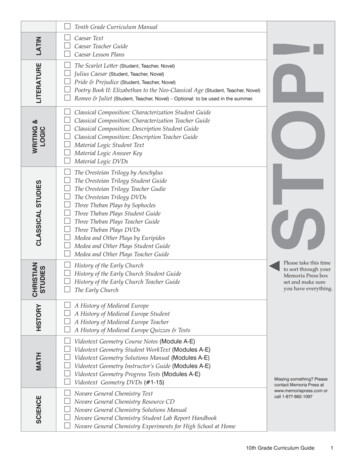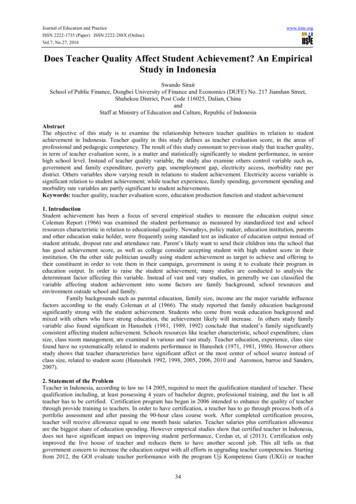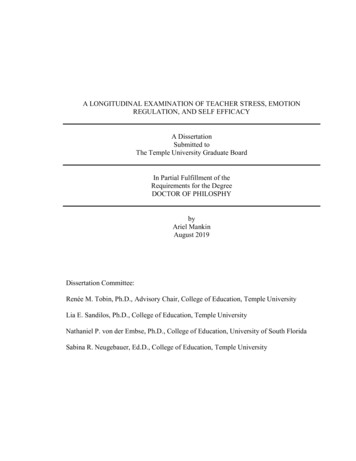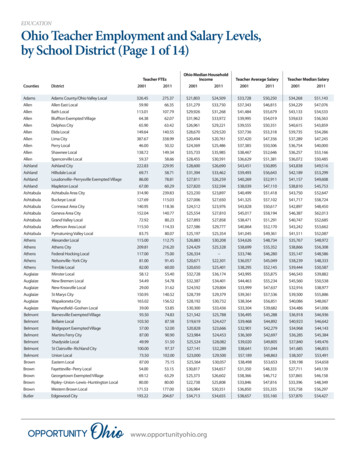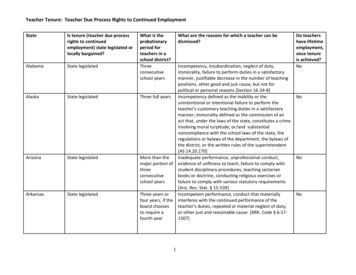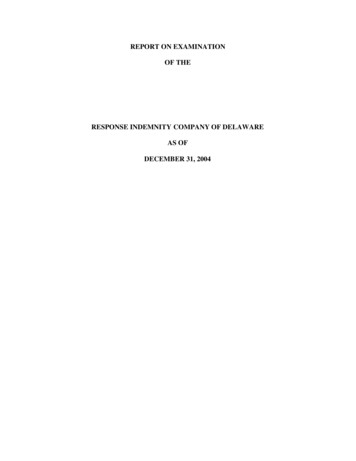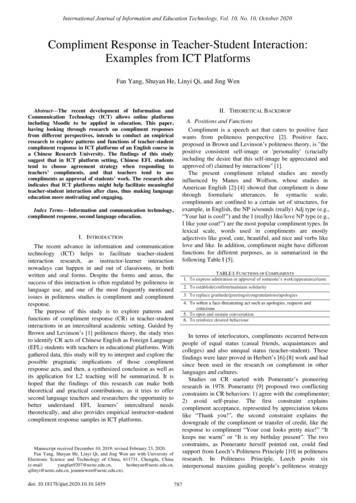
Transcription
International Journal of Information and Education Technology, Vol. 10, No. 10, October 2020Compliment Response in Teacher-Student Interaction:Examples from ICT PlatformsFan Yang, Shuyan He, Linyi Qi, and Jing WenII. THEORETICAL BACKDROPAbstract—The recent development of Information andCommunication Technology (ICT) allows online platformsincluding Moodle to be applied in education. This paper,having looking through research on compliment responsesfrom different perspectives, intends to conduct an empiricalresearch to explore patterns and functions of teacher-studentcompliment response in ICT platforms of an English course ina Chinese Research University. The findings of this studysuggest that in ICT platform setting, Chinese EFL studentstend to choose agreement strategy when responding toteachers’ compliments, and that teachers tend to usecompliments as approval of students’ work. The research alsoindicates that ICT platforms might help facilitate meaningfulteacher-student interaction after class, thus making languageeducation more motivating and engaging.A. Positions and FunctionsCompliment is a speech act that caters to positive facewants from politeness perspective [2]. Positive face,proposed in Brown and Levinson’s politeness theory, is "thepositive consistent self-image or 'personality' (cruciallyincluding the desire that this self-image be appreciated andapproved of) claimed by interactions" [1].The present compliment related studies are mostlyinfluenced by Manes and Wolfson, whose studies inAmerican English [2]-[4] showed that compliment is donethrough formularic utterances. In syntactic scale,compliments are confined to a certain set of structures, forexample, in English, the NP is/sounds (really) Adj type (e.g.,“Your hat is cool!”) and the I (really) like/love NP type (e.g.,I like your coat!”) are the most popular compliment types. Inlexical scale, words used in compliments are mostlyadjectives like good, cute, beautiful, and nice and verbs likelove and like. In addition, compliment might have differentfunctions for different purposes, as is summarized in thefollowing Table I [5].Index Terms—Information and communication technology,compliment response, second language education.I. INTRODUCTIONThe recent advance in information and communicationtechnology (ICT) helps to facilitate teacher-studentinteraction research, as instructor-learner interactionnowadays can happen in and out of classrooms, in bothwritten and oral forms. Despite the forms and areas, thesuccess of this interaction is often regulated by politeness inlanguage use, and one of the most frequently mentionedissues in politeness studies is compliment and complimentresponse.The purpose of this study is to explore patterns andfunctions of compliment response (CR) in teacher-studentinteractions in an intercultural academic setting. Guided byBrown and Levinson’s [1] politeness theory, the study triesto identify CR acts of Chinese English as Foreign Language(EFL) students with teachers in educational platforms. Withgathered data, this study will try to interpret and explore thepossible pragmatic implications of those complimentresponse acts, and then, a synthesized conclusion as well asits application for L2 teaching will be summarized. It ishoped that the findings of this research can make boththeoretical and practical contributions, as it tries to offersecond language teachers and researchers the opportunity tobetter understand EFL learners’ intercultural needstheoretically, and also provides empirical instructor-studentcompliment response samples in ICT platforms.TABLE I: FUNCTIONS OF COMPLIMENTS1. To express admiration or approval of someone’s work/appearance/taste2. To establish/confirm/maintain solidarity3. To replace gratitude/greetings/congratulations/apologies4. To soften a face-threatening act such as apologies, requests andcriticisms5. To open and sustain conversation6. To reinforce desired behaviourIn terms of interlocutors, compliments occurred betweenpeople of equal status (casual friends, acquaintances andcolleges) and also unequal status (teacher-student). Thesefindings were later proved in Herbert’s [6]-[8] work and hadsince been used in the research on compliment in otherlanguages and cultures.Studies on CR started with Pomerantz’s pioneeringresearch in 1978. Pomerantz [9] proposed two conflictingconstraints in CR behaviors: 1) agree with the complimenter;2) avoid self-praise. The first constraint explainscompliment acceptance, represented by appreciation tokenslike “Thank you!”, the second constraint explains thedowngrade of the compliment or transfer of credit, like theresponse to compliment “Your coat looks pretty nice!” “Itkeeps me warm” or “It is my birthday present”. The twoconstraints, as Pomerantz herself pointed out, could findsupport from Leech’s Politeness Principle [10] in politenessresearch. In Politeness Principle, Leech posits sixinterpersonal maxims guiding people’s politeness strategyManuscript received December 10, 2019; revised February 23, 2020.Fan Yang, Shuyan He, Linyi Qi, and Jing Wen are with University ofElectronic Science and Technology of China, 611731, Chengdu, tc.edu.cn,qilinyi@uestc.edu.cn, joanniewen@uestc.edu.cn).doi: 10.18178/ijiet.2020.10.10.1459787
International Journal of Information and Education Technology, Vol. 10, No. 10, October 2020usage. Here, Pomerantz’s first constraint coincides with theAgreement Maxim, the second constraint coincides with theModesty Maxim in Politeness Principle, for AgreementMaxim states “to minimize disagreement between yourselfand others; maximize agreement between yourself andothers”, and Modesty Maxim states “to minimize self-praise;maximize self-dispraise”. Therefore, the intricate interplaybetween the two maxims and constraints makes the art ofCR delicate.B. Patterns of Compliment Response: Chinese vs EnglishLanguageBy definition, compliment is the linguistic act that servesto satisfy the positive face wants of someone and responseto a compliment should naturally be polite, too. However,what is considered to be polite might vary from culture toculture, and also language to language. It is also pointed outthat in many languages, complimentary language frequentlyappears in greeting, thanking, apologizing, opening aconversation for compliment stands for encouragement andreinforcing the solidarity of interpersonal relationships [6].In the English language, CR is summarized to be mainlyof three types: Agreement, non-agreement and otherinterpretations [6], each of them includes severalsub-categories (Table II).CR is acceptance and “thank you”.In Chinese language, compliment response is found to beof a different displaying form [14], [15]. Although highlyvalued in Chinese cultures, many researchers proposed thatCR is often combined with traditional Chinese modest andreserved cultural norms. What is more, by analyzingLeech’s maxim theory, these researchers suggested thatChinese style of polite CR suits the Modesty Maxim best.All these discussions lead to the hypothesis that Chinese CR,different from English, would be reserved and modest.As is shown in the following Table III, a large number ofempirical studies were conducted to testify this hypothesis,covering population from Mainland, Taiwanese Chinese, toChinese immigrants, with academic contexts being themajor background. All of these research findings support thespecific Chinese Modesty Maxim approach of CRhypotheses. However, these studies although reveal atendency in changing proportion of accepting thecompliments, with detailed acceptance proportion growingfrom 1% to 49%, possibly influenced by regionaldifferences and increasing number of EFL learners[16]-[18].TABLE III: CHINESE COMPLIMENT ACCEPTANCE AND REJECTIONSubjectsAcceptanceRejectionMainland Chinese (Xi’an) [19]1.0395Mainland Chinese [20]2080Hong Kong Chinese in Britain [21]4122DCT Mainland Chinese (Kunming) [22]728.93Natural Mainland Chinese (Kunming)[23]15.6333.98Taiwanese Chinese [24]1324Chinese in Australia [14]4938TABLE II: RESPONSE TYPECategory:Sample:1. Agreement1.1 Acceptance1.1.1 Appreciation tokenThank you1.1.2 CommentYeah, it's my favorite too1.2 Non-Acceptance1.2.1 HistoryReally brings out the blue inmy eyes, doesn’t it?1.2.2 Transfer1.2.2.1 ReassignMy brother gave it to me1.2.2.2 ReturnSo is yours2. Non-Agreement2.1 Acknowledgement2.1.1 QuestionDo you really think so?2.1.2 Scale DownIt’s really quite old2.1.3 DisagreementI hate it2.1.4 QualificationIt's alright, but Len's is nicer2.2 No AcknowledgementNo responseIn addition, these studies also pointed out that the hugedifference in Chinese and English CR is causingembarrassment and possible conversational failure in bothacademic and non-academic contexts for Chinese EFLlearners.With review of previous literature, this study intends toconduct its CR research in an intercultural academic context:a transnational higher education institution where ChineseEFL learners, native and non-native English teacherscommunicate through Moodle, an online educationalplatform. The research questions investigated are:1) What are the patterns of compliment response in theplatforms?2) What are the functions of the compliments?3) Are the compliments and compliment responses in theplatforms helpful for teacher-student interaction?This summary is supported by massive empirical studies,with the most famous one conducted in academic contexts,where 1062 CR tokens were gathered throughquestionnaires and discourse completion tests fromparticipants in an American University [8]. Results showedthat 36.65% instances fell into the agreement category,9.98% instances fell into the non-agreement category, andthe rest fell into the other interpretations category.This taxonomy was then used by several similar studiesconducted in other contexts (workplace company andhospital), where similar results were revealed [11], even theone which collected its data from forty typical Americanfilms so as to gain authentic and naturally-occurring datasource [12]. Thus these studies lead to the conclusion thatnot to reject category and Agreement Maxims suit theAmericans politeness strategy in CR best, and Herbert [7]even quoted from an etiquette book saying that “when youare complimented, the only response necessary is “Thankyou” and “A simple thank you is sufficient” [13] to provethat virtually for all American English speakers, the correctIII. METHODOLOGYA. Sources of DataFor the purpose of this study, one open English course onthe online educational platform Moodle, as well as thecourse group formed in Chinese ICT platforms includingQQ and We-chat, were chosen as the main sources forextracting compliment and compliment response tokens. 8native speaker teachers (2 based in Britain, 6 based inChina), 23 non-native speaker teachers(all based in China)and 540 students are enrolled on Moodle in this course, andinteractions between teacher to teacher, teacher to student788
International Journal of Information and Education Technology, Vol. 10, No. 10, October 2020happen on a daily basis on Moodle or relevant platforms.Included in this study were 56 English CR tokens ofChinese EFL learners. Excluded in this study were CRtokens that might be interpreted into different meanings.Here it should also be noticed that in some conversations,emotion icons are used by the respondents as a simple andclear way to express feelings in CR and these emotion iconsare included as data.suitable way in compliment exchanges, thus reducing theirspontaneous strategic reliance on mother tongue. This mightalso explain the frequent “no acknowledgement” responsesin the data, as Internet helped the compliment recipientsavoid encountering the face to face compliment exchanges,so they chose silence when they do not need to giveimpromptu responses.Another interesting fact worth noticing is the complimentrecipients’ frequent usage of emotion icons. Popularemotion icons included “flower” icon meaning “thank you”in appreciation token strategy, and “shy face” “just so so”icon indicating the feeling of being flattered in scale downstrategy. Compared with typing words, choosing emotionicons might be more time-saving in online communications,which probably explains its popularity. However, whetherthose icons can fully explain the recipients’ feelings mightstill be questionable.B. InterviewsInterviews were also conducted to investigate on theattitude of teachers and students towards CR in the platform.1 native speaker teacher and 1 non-native speaker teacherbased in China, as well as 18 students were interviewed.During the interview, the researcher read the CR tokens andthe relevant platform chatting records together with theparticipant. The participants were invited to reflect on theirthinking process when and after responding to thecompliment. These interviews serve as a supplement supportfor the verbal analysis of the pragmatic functions of CR.B. Functions of the ComplimentsAs is summarized in the following Table V, the firstfunction—expressing admiration and approval is the mostpopular, accounting for more than four fifths of the CRsamples, while the third (replace gratitude), fifth (openconversation), and sixth (reinforce desired behavior)functions are not evident. Establishing solidarity andsoftening a face-threatening act then occupied the restproportion.IV. FINDINGSA. Patterns of Compliment ResponseAs is shown in the following Table IV, in the maincategories, agreement responses (52.8%) are slightly morefrequent in relevant conversations compared withnon-agreement responses (48.2%). The majority ofagreement responses fall into acceptance (22 out of 29),especially the direct thank you type (16 out of 22); fornon-acceptance, all instances belong to the reassigntype--transferring the credit to someone else. Two thirds ofthe non-agreement type of responses are noacknowledgement, while in the acknowledgement type,scale down is the most popular (7 out of 9).TABLE IV: RESPONSE PATTERNSNumber1. Agreement291.1 Acceptance221.1.1 Appreciation token161.1.2 Comment61.2 Non-Acceptance71.2.1 History01.2.2 Transfer71.2.2.1 Reassign71.2.2.2 Return02. Non-Agreement272.1 Acknowledgement92.1.1 Question12.1.2 Scale Down72.1.3 Disagreement02.1.4 Qualification12.2 No Acknowledgement18TABLE V: FUNCTIONS OF COMPLIMENTSNumber1. To express admiration or approval of46someone’s work/appearance/taste2. To establish/confirm/maintain 82.1%10.7%3. To replace gratitude /greetings/congratulations /apologies4. To soften a face-threatening act such asapologies, requests and criticisms5. To open and sustain conversation00%47.1%00%6. To reinforce desired behavior00%The result shows that similar to non-academic contexts[5], in academic contexts, the majority of complimentsmight be those expressing approval (or admiration) ofothers’ work. In other words, teachers tended to make morecompliments on individual student’s work or improvement.The second most favored type of compliments might bemaintaining solidarity, with typical phrase of “Well done!Everyone!”, and these were used by teachers to build wholeclass rapport. Softening a face-threatening act was thefunction of the rest compliments, employed by teacherswhen they tried to ease the atmosphere before providingnegative feedback to students.C. Efficiency of Compliment ResponseBoth teachers and students mentioned in the interviewsthat they considered compliment exchange a necessary partin academic communication. Students reported that they felt“encouraged when receiving compliments from teachers”. Inaddition, several students mentioned the establishment of“stronger inter-personal relationship bond with teachers”when they were able to make suitable compliment responsesonline.The native and non-native speaker teachers stated thatThe result contradicts with the mainstream opinion thatChinese people tend to employ non-agreement strategy inCR. One possible reason to explain this phenomenon mightbe that the compliment responses are in English contexts.When EFL learners are communicating in English, theymight obey the targeted language patterns when respondingto compliments. In addition, Internet as the conversationcontext also allows those EFL learners more time toorganize their linguistic responses in a seemingly more789
International Journal of Information and Education Technology, Vol. 10, No. 10, October 2020compliments are helpful tools for them to “motivatestudents” and “build teacher-student rapport”. Theseteachers also suggested that compliment exchanges wouldbe particularly helpful when students were engaged byresponding to the compliments, which could further“facilitate teacher-student interaction”. In a word, bothteachers and students agreed that compliment response is ahelpful for promoting teacher-student interaction.our colleagues in Glasgow College, UESTC, and also theDean Professor Zeng, the Deputy Dean Professor Liu,Secretary Mr. Gao, and Deputy Secretary Ms. He for theirkind help.REFERENCES[1][2]V. IMPLICATIONAbove review and discussion proved that since currentdevelopment of ICT has allowed more intensivecommunication between teachers and students, it has alsobrought wider research area for relevant scholars, postingseveral research questions in related fields: Are there anydifferences between online and off-line complimentexchanges in teacher-student interaction? If so, how?Frequency or content? What could be done to facilitate tudent-student compliment exchanges with the help of ICTplatforms? All of these are areas waiting for furtherinvestigation and cooperation by scholars from ICT andlanguage education fields.Apart from the theoretical implication, this study alsoimplies that a more detailed instructional curriculum for ICTassisted language education is necessary. For languageteachers, more meaningful attempts of teacher-studentinteraction in ICT platforms should be encouraged. Forstudents, suitable intercultural education includingcompliment and compliment response strategies should beoffered. For schools, more systematic instruction on theusage of ICT related skill and pedagogy training should [15]VI. CONCLUSION[16]Before ICT was introduced into language education,teacher-student interaction seemed more of a pedagogicalterm and phenomenon in classroom teaching. However,current research has shown that ICT platforms have helpedto facilitate meaningful teacher-student interaction afterclass, thus making language education more motivating andengaging. As above review and discussion have illustrated,ICT can offer a helping hand in language education boththeoretically and practically. In addition, the discussion alsoreminds current researchers that more attention and effortsshould be paid to ICT assisted language education, and thatteachers should also be encouraged to make moremeaningful teaching related practices on ICT platforms.[17][18][19][20][21][22]CONFLICT OF INTERESTThe authors declare no conflict of interest.[23]AUTHOR CONTRIBUTIONS[24]All authors made contributions to all aspects of this paper.B. Penelope and S. C. Levinson, “Universals in language usage:Politeness phenomena,” in Questions and Politeness: Strategies inSocial Interaction, Cambridge University Press, 1978, pp. 56-311.N. Wolfson, “An empirically based analysis of complimenting inAmerican English. Sociolinguistics and language acquisition, 82-95.M. Kirch, At what age elementary school language teaching?”Modern Language Journal, vol. 40, pp. 399–400, 1983.J. Manes, “Compliments: A mirror of cultural values,”Sociolinguistics and Language Acquisition, vol. 96, p. 102, 1983.J. Manes and N. Wolfson, The Compliment Formula. ConversationalRoutine: Explorations in Standardized Communication Situations andPrepatterned Speech, pp. 115-132, 1981.S. Y. A. M. Yusof and T. B. Hoon, “Compliments and complimentresponses on Twitter among male and female celebrities,” PertanikaJournal of Social Sciences and Humanities, vol. 22, pp. 75-96, 2014.R. K. Herbert, “Say thank you-or something,” American Speech, vol.61, no. 1, pp. 76-88,1986.R. K. Herbert, “The ethnography of English compliments andcompliment responses: A contrastive sketch,” Contrastive Pragmatics,pp. 3-35, 1989.R. K. Herbert, “Sex-based differences in compliment behavior,”Language in Society, vol. 19, no. 2, pp. 201-224, 1990.A. Pomerantz, “Compliment responses: Notes on the co-operation ofmultiple constraints,” Studies in the Organization of ConversationalInteraction, vol. 7, p. 112, 1978.G. Leech, Principles of Politeness, London and New York: Longman,1983.A. Golato, Compliments and Compliment Responses: GrammaticalStructure and Sequential Organization (Vol. 15), John BenjaminsPublishing, 2005.K. R. Rose, “Compliments and compliment responses in film:Implications for pragmatics research and language teaching,” IRAL,vol. 39, no. 4, pp. 309-326, 2001.D. Johnson, Entertaining and Etiquette for Today, Washington, DC:Acropolis, 1979.C. H. Tang and G. Q. Zhang, “A contrastive study of complimentresponses among Australian English and Mandarin Chinesespeakers,” Journal of Pragmatics, vol. 41, no. 2, pp. 325-345, 2009.R. Chen and D. Yang, “Responding to compliments in Chinese: Has itchanged?” Journal of Pragmatics, vol. 42, no. 7, pp. 1951-1963,2010.R. Chen, “Compliment and compliment response research: Across-cultural survey,” Pragmatics Across Languages and Cultures,pp. 79-102, 2010.Z. Ye, How to Compliment and Respond to People in English, Beijing:Chinese Textile Press, 2011.R. Wu, “Attitudes towards compliment responses,” Journal ofHeilongjiang College, vol. 11, no. 3, pp. 101-109, 2012.R. Chen, “Responding to compliments: A contrastive study ofpoliteness strategies between American English and Chinesespeakers,” Journal of Pragmatics, vol. 20, no. 1, pp. 49-75, 1993.K. P. Schneider and I. Schneider, “Bescheidenheit in vier Kulturen:Komplimenterwiderungen in den USA, Irland, Deutschland undChina,” Ethische Konzepte und Mentale Kulturen, vol. 2, pp. 65-80,2000.T. Loh, “Responses to compliments across cultures: A comparativestudy of British and Hong Kong Chinese,” M.S. thesis, Department ofEnglish, Hong Kong City Poly Technique Univ., 1993.Y. Yuan, “An inquiry into empirical pragmatics data-gatheringmethods: Written DCTs, oral DCTs, field notes, and naturalconversations,” Journal of Pragmatics, vol. 33, no. 2, pp. 271-292,2001.Y. Yuan, “Compliments and compliment responses in KunmingChinese,” Journal of Pragmatics, vol. 12, no. 2, pp. 62-68, 2002.M. C. Yu, “Interlinguistic variation and similarity in second languagespeech act behavior,” The Modern Language Journal, vol. 88, no. 1,pp. 102-119, 2004.Copyright 2020 by the authors. This is an open access article distributedunder the Creative Commons Attribution License which permitsunrestricted use, distribution, and reproduction in any medium, providedthe original work is properly cited (CC BY 4.0).ACKNOWLEDGMENTThis work was supported by Glasgow College, Universityof Electronic Science and Technology of China. We thank790
International Journal of Information and Education Technology, Vol. 10, No. 10, October 2020Fan Yang was born in China in 1992. She got hermaster degree at the Chinese University of HongKong and her bachelor degree at Beijing NormalUniversity. Her major field of study is secondlanguage teaching and second language acquisition.She is a lecturer in Glasgow College, University ofElectronic Science and Technology of China. She hadrich experience in the teaching practice ofengineering English and English for academicpurposes.Linyi Qi was born in China in 1986. She got hermaster degree and bachelor degree at SichuanUniversity. Her major field of study is Englishliterature.She is the co-lead and lecturer in Glasgow College,University of Electronic Science and Technology ofChina. She had rich experience in the teachingpractice of English reading and English for academicpurposes.Shuyan He was born in China in 1988. She got hermaster degree at University of Electronic Science andTechnology of China and her bachelor degree atSichuan International Studies University. Her majorfield of study is translation and interpreting.She is a lecturer in University of ElectronicScience and Technology of China. She had richexperience in the teaching practice of English foracademic purposes.Jing Wen was born in China in 1987. She got hermaster degree at Tianjin Foreign Studies Universityand her bachelor degree at Harbin Institute ofTechnology. Her major field of study is appliedlinguistics.She is a lecturer in University of Electronic Scienceand Technology of China with rich experience in theteaching practice of engineering English and Englishwriting.791
adjectives like good, cute, beautiful, and nice and verbs like love and like. In addition, compliment might have different functions for different purposes, as is summarized in the following Table I [5]. TABLE I: F. UNCTIONS OF . C. OMPLIMENTS. 1. To express admiration or approval of someone's work/appearance/taste 2.
